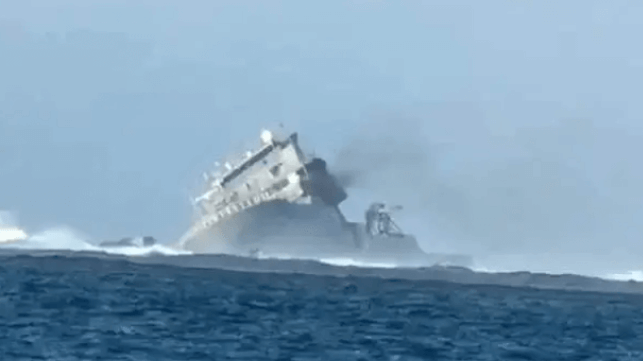New Zealand Survey Ship's Crew Ran Aground Because They Left Autopilot On

The New Zealand Defence Force has released its initial findings on the grounding of navy ship HMNZS Manawanui on a reef off Samoa last month, and it put the blame squarely on mistakes made by the crew.
A Court of Inquiry established that the grounding of the ship was primarily caused by the bridge team's failure to turn off the autopilot, followed by unsuccessful attempts at manual control while manual controls were disengaged.
Manawanui grounded on a reef on the southern side of Samoa on October 5 while conducting survey operations. The ship subsequently caught fire and sank, but all 75 people on board managed to evacuate safely.
In the preliminary findings of the inquiry, NZDF gave a detailed account of a series of mistakes that began on the evening of October 5, when Manawanui was conducting survey operations on the southern side of Apia. Winds were strong at up to 25 knots, and there was a moderate swell.
The inquiry established that at about 1815 hours, the crew attempted a routine turn to starboard, initially to a course of 340 degrees. This would keep them within the survey area. The crew then attempted to turn to starboard towards an easterly course, but the ship did not respond as intended.
Shortly after, the ship left the approved survey area. In an effort to stop the ship, the crew conducted further actions that they believed should have resulted in reverse thrust. Manawanui did not slow or stop, and instead started to accelerate towards the reef, grounding for the first time at or about 1817 at a speed of more than 10 knots. The ship then continued to travel for around 400 yards further before becoming stranded, grounding multiple times along the way.
The crew was only able to regain full control of the ship’s propulsion system 10 minutes later when they managed to disengage the autopilot. The inability to turn the ship to an easterly direction from the 340 degree course and stop the ship is attributed to the ship being in autopilot mode.
The events that followed saw the crew unsuccessfully attempt to maneuver the ship off the reef. Half an hour after the initial grounding, the decision was made to abandon ship. Manawanui’s generators were left running, which contributed to the successful abandonment process and likely prevented serious injuries or death, but caused the ship to suffer a series of catastrophic fires the next morning. The fires led to her capsizing and sinking.
“The direct cause of the grounding has been determined as a series of human errors which meant the ship’s autopilot was not disengaged when it should have been,” said Chief of Navy Rear Admiral Garin Golding. “The crew did not realize Manawanui remained in autopilot and, as a consequence, mistakenly believed its failure to respond to direction changes was the result of a thruster control failure."
Golding added that having mistakenly assessed a thruster control failure, standard procedures should have prompted the crew to check that the ship was under manual control rather than in autopilot. That check did not occur, so the ship remained in autopilot, maintained a course towards land, and then went hard aground.
The NZDF expects to complete a wider inquiry by the first quarter of next year, which could lead to a separate disciplinary process for the crew.
